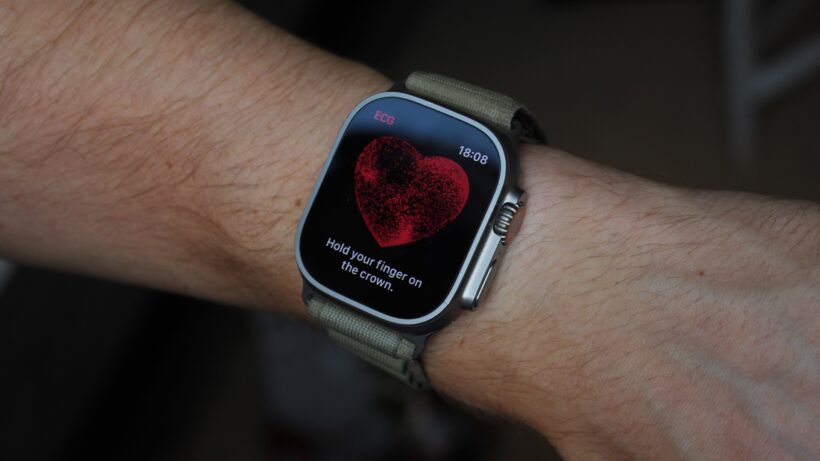Everything you need to know about using Apple's life-saving heart health feature.
The Apple Watch introduced electrocardiogram (ECG) heart measurements in 2018, and the feature has been saving lives ever since.
Available on the Apple Watch Series 4-10 and Ultra 1/2, ECG readings provide users with medical-grade, FDA-approved insights into their heart rhythm.
The 30-second test can help identify a potential heart rate abnormality, which is a sign of atrial fibrillation (AFib). The condition causes irregular and rapid heart rates – and can go unnoticed in those affected.
And it’s serious. “AFib increases the risk of stroke, heart failure, and other heart-related complications,” according to the Mayo Clinic.
That’s the basic overview, but there’s a lot more to understand about how the Apple Watch ECG app functions on your wrist.
In this guide, we’ll cover all the details of the innovative health feature, including its accuracy compared to medical devices and how to set it up.
What is an ECG measurement?

An ECG reading records the heart’s electrical activity over a short period. Typically, this is done with a medical-grade ECG machine, although Apple has incorporated this health technology into its smartwatches.
It does this by using the electrical heart rate monitor on the underside of the Apple Watch and the Digital Crown, where users need to place a finger from the opposite hand. This allows the Watch to monitor the heartbeat.
The ECG reading checks whether the heart’s upper and lower chambers are in rhythm. If it detects they are out of rhythm, this could be a sign of the heart condition atrial fibrillation.
In a 30-second test, the Apple Watch can detect signs of AFib, but you’ll likely need to perform the test multiple times to get an accurate indication.
Are Apple Watch ECG readings accurate?
Since Tim Cook stood on stage and announced the arrival of the ECG app, cardiologists and health experts have speculated on just how accurate the Watch is at detecting irregular rhythms.
After all, this kind of thing would usually be reserved for professional equipment handled by medical professionals – not a tech company.
Apple has acknowledged there’s plenty to do before the feature fully reaches its potential. However, it has published the results of its related Apple Heart Study to show some of its efficacy, which Stanford University also had a hand in.
To obtain clearance from the FDA in the US and then the CE mark for use in the EEA, it must meet a certain standard of accuracy. In the study, during testing of 600 subjects in a controlled environment, the Apple Watch achieved 99.6% accuracy in detecting sinus rhythm classification and 98.3% accuracy in classifying AFib.
The technology isn’t flawless, and the Watch can’t definitively confirm that you have AFib. Even when your heart is monitored throughout the day, it isn’t continuous. It also can’t detect signs of heart attacks, strokes, or other heart conditions.
How to set up the ECG app on Apple Watch
As mentioned, you must have an Apple Watch Series 4-10 to access the ECG feature.
The ECG app requires specific Digital Crown technology to record the electrical pulses. So, users with an Apple Watch 3 or below won’t be able to use the feature.
You also need to ensure your iPhone and Apple Watch are running the latest version of iOS and watchOS, as this will bring your Health app and ECG app up to date.
Next, open up the Apple Health app on your phone.
If it’s not set up already, you’ll likely get a prompt to do so. For this, all you need to do is enter your date of birth, then you’ll be asked to take your first ECG reading.
How to take an Apple Watch ECG reading

After completing the initial setup, you can take an ECG reading at any time by going into the ECG app on the Apple Watch itself.
Before you go any further, you want to ensure the watch is correctly placed on your wrist – not too tight or too loose – and then, ideally, rest your arm on something.
That’s what Apple advises, at least, though we’ve found that as long as you’re reasonably still it has no problem getting a reading.
Then, touch your index finger from the opposite hand against the Digital Crown. You don’t need to do this too hard – just enough that it’s covering the circle entirely.
You’ll then see a real-time graphic of your heart rate and a timer counting down from 30 seconds. After 30 seconds, the Watch will be able to give you the results.
Apple Watch ECG results: What do they mean?
Sinus rhythm: If everything is good and your heartbeat is in a uniform pattern between 50 and 100 BPM, you’ll see ‘Sinus rhythm’. Phew – but we would still recommend doing it several times and turning on irregular rhythm notifications (more on that below).
Atrial fibrillation: The Watch has detected an irregular heartbeat pattern within those same heart rate boundaries. If you get this result, you should perform the test several times and consult your doctor.
Low or high heart rate: The reading is deemed inconclusive if your heart rate is higher than 100 BPM or lower than 50 BPM. There are copious reasons for this; a high heart rate could come from exercise, stress, or even alcohol, while a low one can come from intense training. If you find your heart rate too low or high, you should find out why and, if necessary, consult a doctor.
Inconclusive: It’s possible for the ECG app to deliver this result, which can arise from many things, including too much movement during the test or having the Watch not fitted correctly on your arm.
Set up irregular rhythm notifications on the Apple Watch
In addition to readings you perform manually, you can also have the Apple Watch take occasional readings (usually when you’re still) to detect signs of irregular heart patterns.
While periodic checks are helpful, continuous monitoring gives the Apple Watch a more complete view of how your heart is functioning. Follow the steps below to turn on irregular rhythm notifications.
- Open the Apple Health app and tap ‘Health Data’.
- From there, tap on the Heart, scroll down to the bottom, and tap ‘Irregular Rhythm Notifications’. You’ll need to enter your date of birth again and tell the app whether you’ve been diagnosed with atrial fibrillation before.
- The Watch will then monitor for signs of atrial fibrillation, and, if it detects signs on multiple occasions, it’ll send you a notification.




